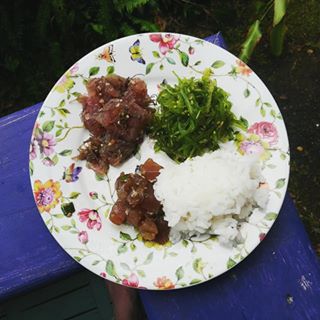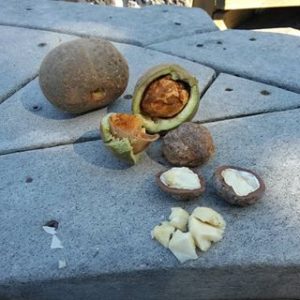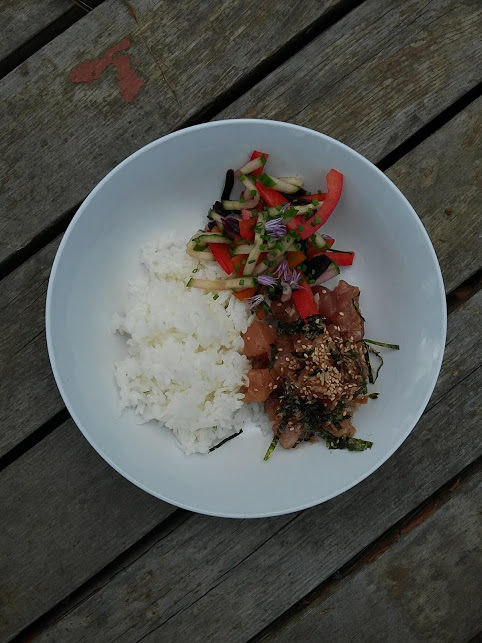
The first time I ate poke was one of the most blissful moments of my entire life. It was at a nondescript concession on the highway just south of Captain Cook, on the big island. We ordered at a window. The menu board actually said “Ahi Special”, not poke. We sat on plastic chairs on a covered patio that looked onto the ocean, and I ate my sticky white rice, fresh avocado, and marinated tuna. That was a truly special moment, but we had many other great poke experiences later that trip, notably at Da Poke Shack in Kona and the Suisan Fish Market in Hilo. Marinated fish and rice. So simple. So good. I have a special room in my heart for that dish.
A few years later there was a miniature poke craze in our city, with two poke shops opening almost simultaneously, and poke appearing on other menus that it had no business being on. I haven’t eaten poke at an Edmonton restaurant. Not because I think it will be bad, but because I want to keep it associated with my memories of Hawaii.

Sorry, I got way ahead of myself there. If you are unfamiliar, these are the basics of poke. First, it is pronounced something like POH-kay. Second, it is essentially chopped fish, raw but marinated. Traditionally white-fleshed reef fish like spearfish would have been used, but nowadays ahi tuna is by far the most common base. Traditional poke contains ‘inamona (ground kukui, also known as candlenut, pictured at right) and limu (a kind of fresh seaweed). In modern Hawaii there is a huge Japanese influence on the food, and a lot of modern poke has Japanese pantry items like soy and sesame stand in for the traditional Hawaiian ingredients. This style is referred to as “shoyu” poke.
The keys to great poke are great fish and restraint. Personally I think adding things like mango or pineapple or mayonnaise is disgraceful, but I’m pretentious like that.
As to sides… short-grain white rice like Calrose is a must. You usually have the option to add furikake (adorably called “sprinkles” or “Hawaiian sprinkles” at some shops). Furikake is a Japanese garnish, a mixture of sesame seeds, bonito flakes, and dried seaweed. I also love the “seaweed salad” that is usually on offer. It is electric green and crunchy and moist and a fantastic contrast to the fish. I’ve actually seen this salad sold in styrofoam trays at Superstore here in Edmonton, but the ingredient list was terrifying so I didn’t try it. It’s kind of sad but at home I make some kind of slaw, either cabbage or cucumber, to stand in for the seaweed.

Shoyu Poke
Ingredients
- 275 g albacore or ahi tuna
- 1 tbsp soy sauce
- 1/2 tsp sesame oil
- 1 tsp lime juice
- 2.5 g kosher salt
Procedure
- Clean the tuna, removing any silverskin. Cut tuna into 1/2″ cubes.
- Add remaining ingredients and gently mix by hand. Refrigerate for at least an hour before eating. Good for 24 hours
Rice for Poke
Ingredients
- 425 g Calrose rice (2 cups)
- 540 g cool water
- 5 g kosher salt
Procedure
- Put the rice in a deep bowl and cover with water. Stir vigorously to rinse starch from the surface of the rice. The water will become very cloudy, almost resembling milk. Strain away the starchy liquid and repeat the rinsing process two more times.
- Drain the rice thoroughly.
- Combine rice, cool water, and salt in the bowl of a rice cooker. Let stand 20-30 minutes. Pre-soaking the rice in this manner makes for more even cooking.
- Start the rice cooker.
- Once the rice cooker has switched from its cooking setting to its holding/warm setting, let the rice stand, covered, another 15 minutes.
- Fluff the rice and serve.